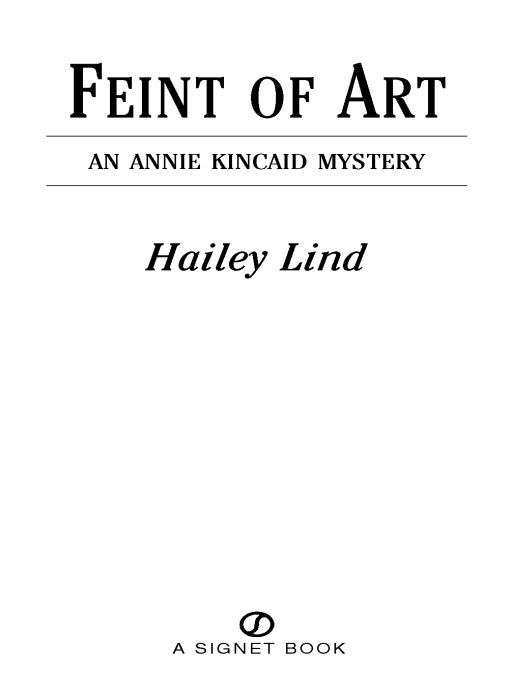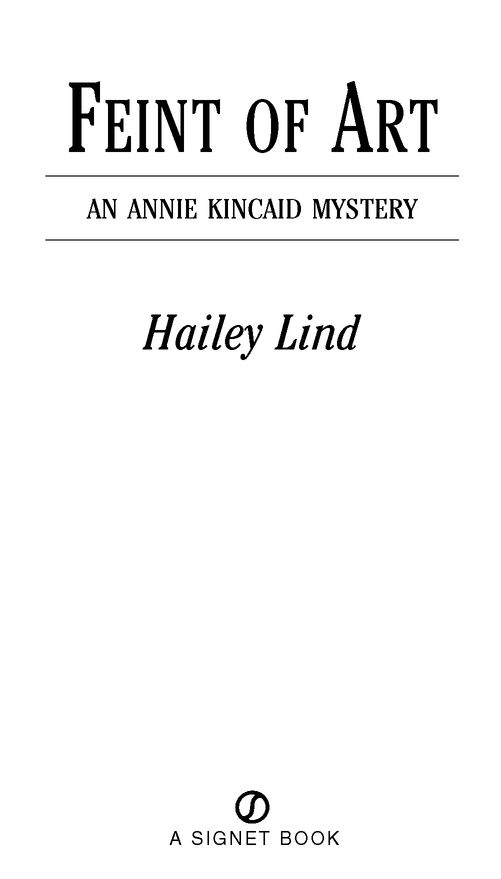Feint of Art:
Authors: Hailey Lind


Table of Contents
The Glamorous Life
My studio specialized in fake—sorry, faux—finishes. I was a natural. I made new surfaces look old, wood look like marble, and plaster look like wood. Gradually I branched out into murals, portraits, and even antique reproductions, always taking pains to ensure they could not possibly be passed off as Old Masters. Now, at the age of thirty-one, I was the owner of a reasonably successful business, meaning that most months I brought in enough to support myself and to pay my assistant, Mary. It wasn’t a lot, but I managed to keep my head above water.
As long as I dog-paddled furiously.
People loved to think of the art world as a mysterious and potentially dangerous milieu. The artistic life was fulfilling, exciting, and a whole lot of fun, but in my experience, at least, it was distinguished less by drama than by long hours, low pay, and plenty of grunt work. Provided, of course, that I stayed away from my grandfather’s world of fakes, frauds, and felons.
But despite my best efforts, that world had a way of sneaking up and biting me in the butt when I least expected it. . . .

SIGNET
Published by New American Library, a division of
Penguin Group (USA) Inc. 375 Hudson Street,
New York, New York 10014, USA
Penguin Group (Canada), 90 Eglinton Avenue East, Suite 700, Toronto,
Ontario M4P 2Y3, Canada (a division of Pearson Penguin Canada Inc.)
Penguin Books Ltd., 80 Strand, London WC2R 0RL, England
Penguin Ireland, 25 St. Stephen’s Green, Dublin 2,
Ireland (a division of Penguin Books Ltd.)
Penguin Group (USA) Inc. 375 Hudson Street,
New York, New York 10014, USA
Penguin Group (Canada), 90 Eglinton Avenue East, Suite 700, Toronto,
Ontario M4P 2Y3, Canada (a division of Pearson Penguin Canada Inc.)
Penguin Books Ltd., 80 Strand, London WC2R 0RL, England
Penguin Ireland, 25 St. Stephen’s Green, Dublin 2,
Ireland (a division of Penguin Books Ltd.)
Penguin Group (Australia), 250 Camberwell Road, Camberwell, Victoria 3124,
Australia (a division of Pearson Australia Group Pty. Ltd.)
Penguin Books India Pvt. Ltd., 11 Community Centre, Panchsheel Park,
New Delhi - 110 017, India
Australia (a division of Pearson Australia Group Pty. Ltd.)
Penguin Books India Pvt. Ltd., 11 Community Centre, Panchsheel Park,
New Delhi - 110 017, India
Penguin Group (NZ), cnr Airborne and Rosedale Roads, Albany,
Auckland 1310, New Zealand (a division of Pearson New Zealand Ltd.)
Penguin Books (South Africa) (Pty.) Ltd., 24 Sturdee Avenue,
Rosebank, Johannesburg 2196, South Africa
Auckland 1310, New Zealand (a division of Pearson New Zealand Ltd.)
Penguin Books (South Africa) (Pty.) Ltd., 24 Sturdee Avenue,
Rosebank, Johannesburg 2196, South Africa
Penguin Books Ltd., Registered Offices:
80 Strand, London WC2R 0RL, England
80 Strand, London WC2R 0RL, England
First published by Signet, an imprint of New American Library,
a division of Penguin Group (USA) Inc.
a division of Penguin Group (USA) Inc.
eISBN : 978-1-101-19844-5
First Printing, January 2006
All rights reserved
 REGISTERED TRADEMARK–MARCA REGISTRADA
REGISTERED TRADEMARK–MARCA REGISTRADAWithout limiting the rights under copyright reserved above, no part of this publication may be reproduced, stored in or introduced into a retrieval system, or transmitted, in any form, or by any means (electronic, mechanical, photocopy, recording, or otherwise), without the prior written permission of both the copyright owner and the above publisher of this book.
PUBLISHER’S NOTE
This is a work of fiction. Names, characters, places, and incidents either are the product of the author’s imagination or are used fictitiously, and any resemblance to actual persons, living or dead, business establishments, events, or locales is entirely coincidental.
The publisher does not have any control over and does not assume any
responsibility for author or third-party Web sites or their content.
responsibility for author or third-party Web sites or their content.
The scanning, uploading, and distribution of this book via the Internet or via any other means without the permission of the publisher is illegal and punishable by law. Please purchase only authorized electronic editions, and do not participate in or encourage electronic piracy of copyrighted materials. Your support of the author’s rights is appreciated.
To Mom and Dad
whose sage and practical advice to pursue careers in the
computer industry produced an artist, a historian,
and an art historian.
computer industry produced an artist, a historian,
and an art historian.
Acknowledgments
Many thanks to Mary Ann Roby of A-1 Editing Service, who helped to whip this baby into shape; to Kristin Lindstrom of Lindstrom Literary Group, for taking a chance on the unknown Hailey Lind; and to Martha Bushko of NAL/Signet, for her faith in art and for making it all happen.
Thanks as well to John, whose Medici-like patronage has made the artistic life possible for more than a few; to Jorge, Candida, Susan, Sandra, Karin, Steve, and Karen, for their thoughtful critiques and unflagging support; to J.C., for always believing, and for a lot of good scotch; to Shay and Suzanne, for food, friendship, and getting married; to Mary for being Mary; to Anna, for refusing to buy another book until this one was published; to the entire MVSC, for uncommon neighborliness . . . and above all to Malcolm and Sergio, for all the joy.
Prologue
“Georges,
please
—try to concentrate on what I’m saying,” I persisted. “It is illegal and immoral to forge art.”
please
—try to concentrate on what I’m saying,” I persisted. “It is illegal and immoral to forge art.”
“Ah, but my agent assures me that there’s no law against
writing a book
about forging art,
cherie
. As to whether it is immoral, well . . .”
writing a book
about forging art,
cherie
. As to whether it is immoral, well . . .”
“You already have an agent?” I asked, momentarily distracted from my halfhearted moral outrage.
“But of course, Annie! It is a wonder, this book. It is the ultimate tool for the democratization of art, a way for me to spread the joys of . . .”
I stopped listening out of an instinct for self-preservation. Georges was spreading something, all right, but it sure wasn’t joy. My hand tightened around the telephone as my mind reeled at what this might mean for me. For the past several years I had been working like a dog to establish myself as a legitimate artist and faux finisher in San Francisco, determined to distance myself from my grandfather Georges LeFleur’s world of art felons, forgers, and fakes.
And now he was writing a “memoir” that would no doubt include so many professional secrets, not to mention scores of recipes for committing art fraud, that it might as well be a required textbook for “Forgery 101.” In certain circles, what Grandfather was proposing was roughly akin to publishing instructions for how to build an atomic bomb using common household cleaners.
I was his beloved granddaughter.
I was trying to talk him out of it.
I didn’t stand a chance.
“Answer me this,
cherie
. Just this one question, and I will agree not to publish this wonderful tome.”
cherie
. Just this one question, and I will agree not to publish this wonderful tome.”
I perked up.
“Why should a painting that is considered exquisite on Monday, and is revealed as a fake on Tuesday, be reviled on Wednesday? Tell me: how has the painting changed? Is it any less beautiful? Any less a work of art?”
I sat back, deflated. I didn’t know. That was a big part of my problem. In addition to inheriting my grandfather’s artistic talent, I had also developed a tendency toward moral flexibility—at least when it came to art. I tried to stifle it, but it wasn’t easy. Fighting genetics never was.
According to family lore, at the age of eighteen months I had toddled across the room, plucked the paintbrush from my grandfather’s hand, and corrected the shading on a “Renoir” that Georges was painting for a financially strapped German baroness who had been forced to quietly sell the original.
At the age of ten, I won a California state Masters of Tomorrow competition with a brilliant copy of Leonardo da Vinci’s
Mona Lisa,
was proclaimed a prodigy, and had my painting hung with great fanfare in the Governor’s Mansion in Sacramento. When the artist is ten, the ability to paint a fake is considered adorable.
Mona Lisa,
was proclaimed a prodigy, and had my painting hung with great fanfare in the Governor’s Mansion in Sacramento. When the artist is ten, the ability to paint a fake is considered adorable.
At the age of sixteen, I waged a three-month-long campaign to convince my skeptical parents to allow me to spend the summer in Paris with Georges, who insisted that arthritis had long since forced him to give up his life of crime. No, no, he swore, he would simply teach me French.
Grandfather was a man of his word about the language, if not the life of crime. I learned to say “I am afraid you are mistaken, good sir,” “I am just a tourist,” and “I must insist upon calling my attorney” in French as well as in five other European languages, plus Cantonese.
Most of what I actually learned, though, was how to forge art, as the only thing arthritic about Grandfather was his moral compass. By the end of that summer Georges and I had managed to flood the European art world with our forged sketches, temporarily causing a brief but devastating crash in the market for Old Master drawings.
The eve of my seventeenth birthday was spent in a dank Parisian jail, where those French phrases had come in handy. And where I vowed, as God was my witness, never to listen to my grandfather again.
“
Allô
, Annie? Are you there? What is your answer,
cherie
?”
Allô
, Annie? Are you there? What is your answer,
cherie
?”
I sighed.
“The only thing I know for sure, Grandfather, is this: genuine art is priceless and forgery gets you arrested. And that’s enough of a difference for me.”
It wasn’t much of a comeback, but it was the best I had.
Chapter 1
Disagreement,” unfinished manuscript,
Reflections of a World-Class Art Forger
Our eyes met. I tried to keep a poker face. I failed.
“Ah,
hell,
” Ernst swore softly.
hell,
” Ernst swore softly.
“So don’t tell anyone it’s a fake. Who would know?” My voice echoed in the nearly empty vault.
“I will not be party to a fraud,” he snapped. There was a sheen developing on Ernst’s elegant brow, which I noted with guilty pleasure. It was kind of fun to see an ex-boyfriend sweat. Especially one who had dumped me so unceremoniously.
“Besides,” Ernst added, “
you
knew.”
you
knew.”
“I could be wrong,” I lied.
He shook his head and sighed. “You’re never wrong about forgery. I had my doubts anyway. That’s why I asked you to meet me here tonight.”
That’s why he
begged
me to meet him at the Brock Museum in the middle of the night, to be more precise. I wasn’t exactly welcome during regular business hours.
begged
me to meet him at the Brock Museum in the middle of the night, to be more precise. I wasn’t exactly welcome during regular business hours.
Other books
EllRay Jakes The Recess King! by Sally Warner; Illustrated by Brian Biggs
Scrapyard Ship 4 Realms of Time by Mark Wayne McGinnis
City of Bones deleted prologue by Cassandra Clare
Gnomes of Suburbia by Viola Grace
The Wicked Deeds of Daniel Mackenzie by Jennifer Ashley
Never Use a Chicken and Other Stories by Jim Newell
Calibre by Bruen, Ken
Front Man 3 : Full Frontal (Part #3 of the Front Man series) by Bell, Adora
Bone Dust White by Karin Salvalaggio
